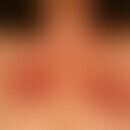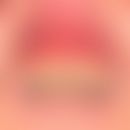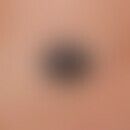DefinitionThis section has been translated automatically.
ClinicThis section has been translated automatically.
Stomatitis, erosions, lichen planus mucosae, recurrent aphthous changes, urticarial exanthema (very rare). Not infrequently, an "amalgam allergy" is a sign of a somatoform disorder and thus requires a very differentiated approach.
You might also be interested in
DiagnosisThis section has been translated automatically.
Medical history, epicutaneous test for mercury derivatives.
Epicutaneous tests with the various mercury compounds for the detection of a type IV allergy show variable, not always reproducible results. The epicutaneous test should be performed with standardized 1% mercury(II) amine chloride in petroleum jelly and 5% amalgam in petroleum jelly. Exposure for 24 or 48 hours and late readings (at least 72 hours) are required. Due to the wide range of morphological reaction possibilities, the test should only be carried out by experienced, dermatologically versed allergologists.
Allergic reactions to phenyl mercury borate or acetate or to other mercury compounds (e.g. thiomersal) are at best vague indications of the presence of an allergy to inorganic mercury.
TherapyThis section has been translated automatically.
- If there are no clinical symptoms, amalgam fillings can be left in place.
- In case of clinical symptoms as well as temporal and topographical connection with an amalgam filling, fillings should be replaced, e.g. with ceramic or biogold fillings. Any further contact with mercury should be avoided.
- As a precaution, amalgam should be avoided in any future cavity restoration.
Note(s)This section has been translated automatically.
Doctors are often confronted with the question of an allergy to amalgam in dental fillings. Mostly complex, elusive symptoms are expressed. They are often also made aware by a dentist or a "holistic" arguing dental technician of the possibility of material replacement as a solution to their health problems.
LiteratureThis section has been translated automatically.
- Bailer J et al (2003) Ill due to amalgam? 10 rules for managing the symptomatic patient. MMW progression Med 145: 34-38
- Dunsche A et al (2003) Lichenoid reactions of murine mucosa associated with amalgam. Br J Dermatol 148: 741-748
- Fuchs Th (1994) Statement of the DKG of DDG on amalgam allergy. dermatologist 45: 415
- Koch W (1995) Health risks of amalgam fillings from a dermatological and dental perspective. Z Dermatol 181: 6-15
- Lazarov A et al (2003) Contact orofacial granulomatosis caused by delayed hypersensitivity to gold and mercury. J Am Acad Dermatol 49: 1117-1120
Incoming links (5)
Copper (overview); Lichen planus mucosae; Mercury in dermatology ; Nickel allergy; Sensitivity multiple chemical ;Outgoing links (9)
Allergy (overview); Aphthae (overview); Epicutaneous test; Erosion; Exanthema, urticarial; Lichen planus mucosae; Mercury allergy; Somatoform disorders; Stomatitis;Disclaimer
Please ask your physician for a reliable diagnosis. This website is only meant as a reference.




